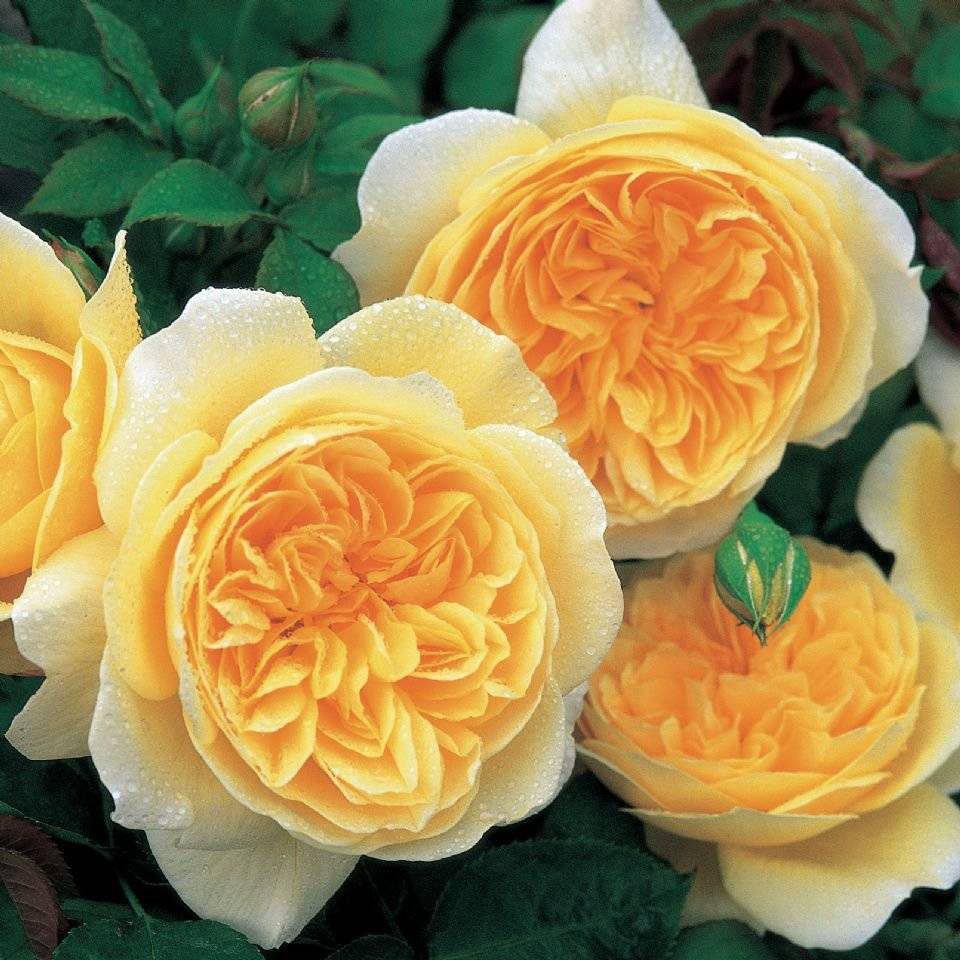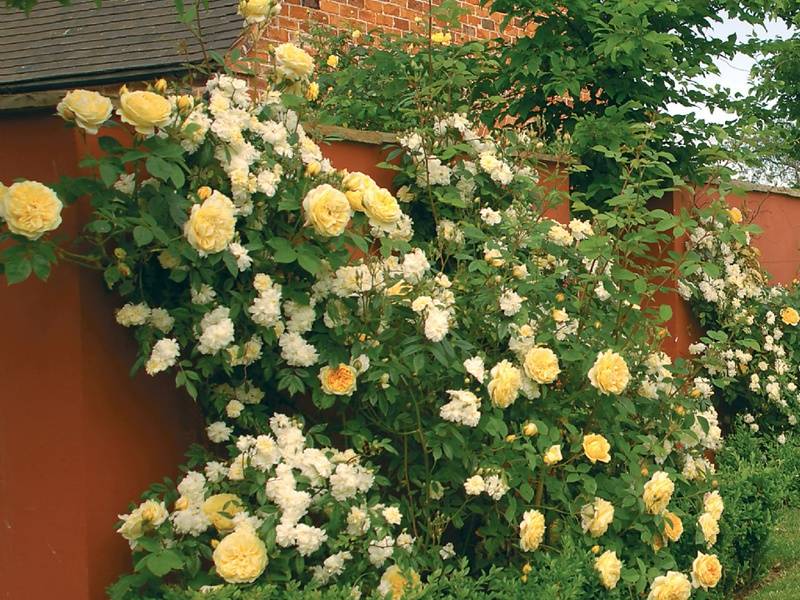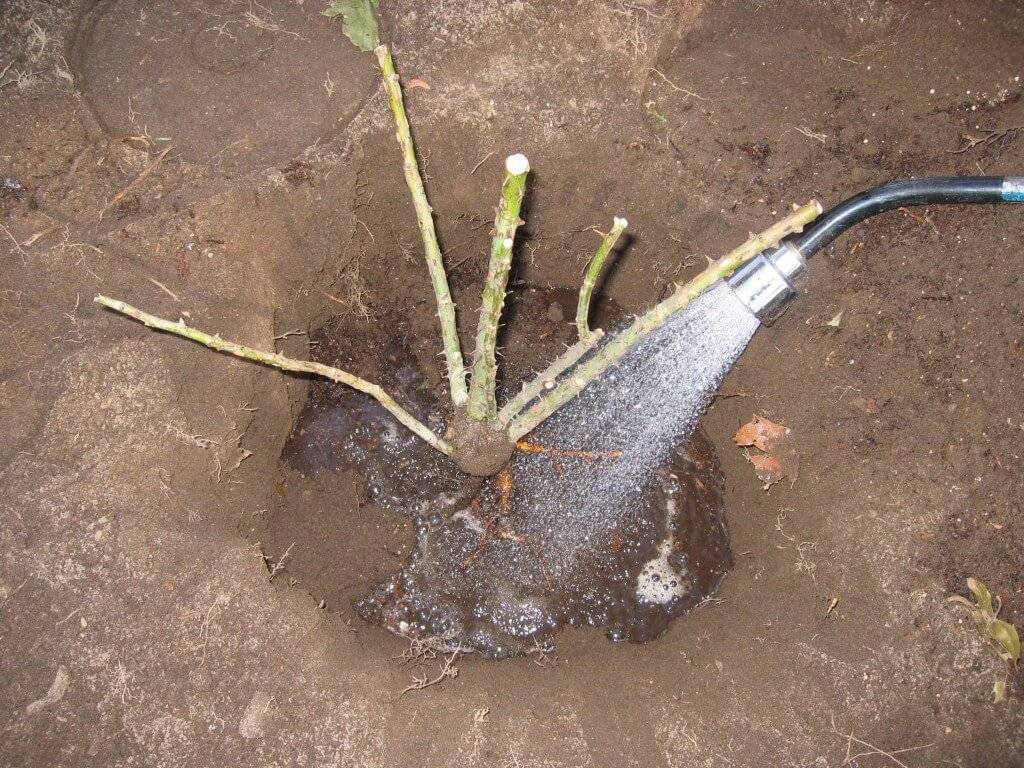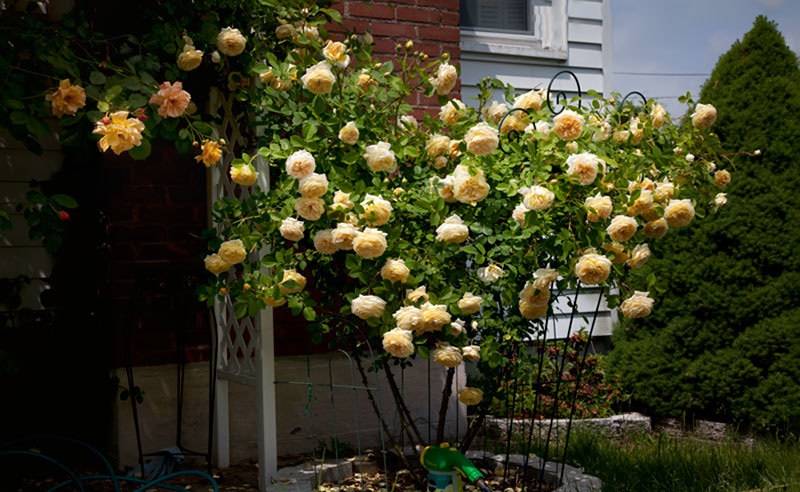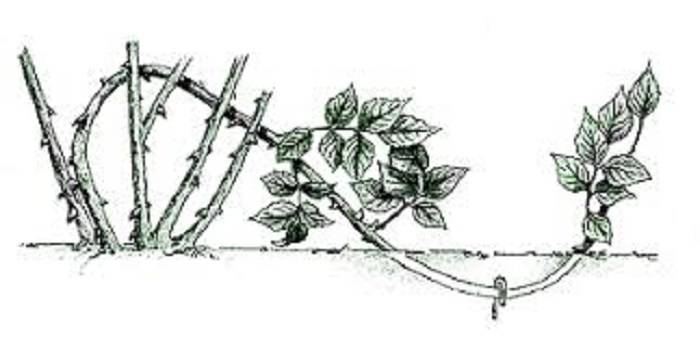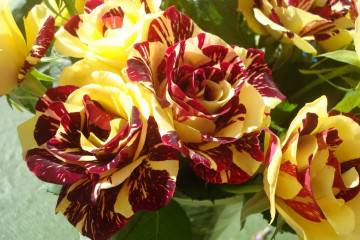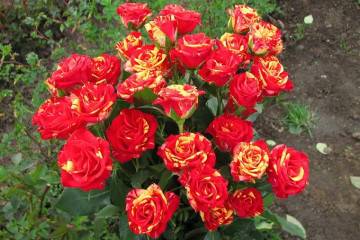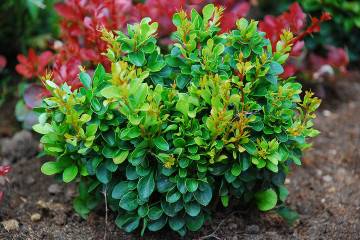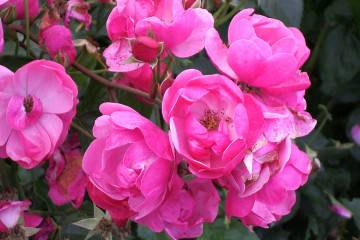Rose Teasing Georgia (Teasing Georgia) - variety description
Content:
Rose Teasing Georgia is distinguished by its original and attractive appearance. During its flowering, the aroma of caramel with a small amount of fruity notes spreads throughout the area.
Rosa Teasing Georgia (Teasing Georgia) - what is this variety
The variety and its name appeared in 1998, when a 50-year-old journalist wanted to give his wife a gift that she would remember and like. For these purposes, breeder D. Austin bred a new plant, which later became known as Teasing Georgia, which is translated from English as "teasing Georgia" (the name of the journalist's wife).
Brief description and characteristics
The plant itself is no less attractive than its history. Large double flowers inside a rich yellow bud, which dies down to the edges of the petals, turning into a pale cream shade. The bush is quite tall and grows strongly, in height it can reach from 1 to 2 m, and in width about 1 m.
The buds are 10 cm in diameter, while their number on the shoot is quite large. They are shaped like a vase or bowl. The flowers that appear first are the largest, the rest are slightly smaller. The stems have a small number of thorns.
Advantages and disadvantages of the variety
The flower has a number of advantages over other varieties of roses:
- abundant flowering;
- bright color;
- pleasant aroma;
- a large number of buds;
- frost resistance;
- disease resistance.
The variety has only one drawback - flowers cannot be used to create bouquets and flower arrangements, since on a thin shoot they quickly lose petals, and also begin to fall off.
Use in landscape design
The main milestone in the use of the English rose of the Teasing Georgia variety is landscape design. Since it cannot be used in other industries, the plant is used to beautify a garden or park area. The culture is required to be tied to supports, since the Georgina rose is climbing, which should be taken into account by novice growers.
Growing a flower
Planting English roses is somewhat different from planting other types of plants. To make them feel comfortable, it is recommended to follow certain rules: prepare a high-quality landing site, as well as planting material.
Any option can be used as planting material: seeds or seedlings. However, a large percentage of seeds may not germinate. It is also worth understanding that the preservation of the characteristics of the parent plant may not be carried out, and therefore the gardener will receive another bush. With seedlings, everything is easier - they take root better, are more likely to take root, and also do not require certain care.
Seat selection
Teasing Georgia rose requires planting where there is a nearby fence or wall. They will help protect the plant from gusty winds, which is especially dangerous in winter, as it can blow off the snow cover that protects the flower from frost.
How to prepare the soil and flower for planting
Before planting, the seedlings should be prepared: it is necessary to inspect the roots and remove the damaged ones, treat the cut sites with activated or charcoal to disinfect them. Then it is required to place the seedling for 12 hours in a solution of the accelerator of root formation.
Soil preparation should start early:
- Dig a hole about half a meter deep and wide. Do it as a transhipment, dividing the upper and lower layers into two parts.
- Mix soil with fertilizer.
- The upper layer must be lowered to the bottom of the fossa, and the lower one must be left for pouring.
This substrate will not only be rich in useful microelements, but also saturated with oxygen, thanks to which the roots will develop faster.
Planting procedure step by step
First of all, you need to dig a hole 45-50 cm deep and wide.A small amount of drainage should be poured into its bottom, which can be small pebbles and coarse sand. A plant should be placed on top of the embankment, carefully distributing the roots along the hill, and then sprinkle them with earth, lightly pressing on it. After planting, it is necessary to water the plant abundantly.
Plant care
Despite the rather unique look and different planting method, the plant should be looked after in the same way as for other varieties of roses. This means that you can relieve yourself of responsibility for memorizing other rules that would be required to follow when looking after a flower.
Watering rules and humidity
Watering is recommended in the evening, strictly under the root of the bush. Despite the fact that the plant can survive the rain, from which the flowers will not wither, it is still not worth risking them once again. The English rose does not require high soil moisture, and therefore watering the soil is required by 2 cm, no more.
A dry climate can cause the bush to dry out, but excessive humidity will not improve its condition. If the root system of the rose is waterlogged all the time, this can contribute to the appearance of rot. However, high air humidity can contribute to the development of fungus or the influx of insects.
Top dressing and soil quality
The soil for cultivation should be light, oxygenated, rich in nutrients. For active growth and abundant flowering, constant fertilization is required. In the first year after disembarkation, such activities may not be carried out. Starting from the second year, it is worth making the following types of feeding at certain periods:
- during the growing season, the plant needs nitrogen to form stems;
- during the formation of buds and subsequent abundant flowering, nitrogen and phosphorus fertilizers are required;
- to increase frost resistance, it is worth starting feeding with potassium at the end of autumn.
It is not recommended to risk the plant by feeding in the wrong order, as this will confuse the rose, it may begin to lay buds during the dormant period, or during the budding period, begin to grow abundantly greenery.
Pruning and replanting
Plant formation is especially important to the plant. Pruning should be done before frost in the fall and early spring. Prophylactic removal of dry and broken shoots will allow the bush to release fresh shoots more intensively. You can trim the stems at will:
- strong pruning - shortening the shoots by half their length;
- medium pruning - removing only lateral shoots;
- weak pruning - removal of a fifth of the stem.
Features of wintering a flower
Before wintering, it is recommended to remove all fallen leaves from under the bush, and also to treat the plant with drugs that prevent the appearance of a fungal infection. Not every winter there is a large amount of snow, and therefore it is worth building an additional shelter. It is made of spruce branches, which is covered with lutrasil on top.
The branches need to be bent to the ground. If they are not flexible enough, you can gently dig in from the side opposite to the fold. So that the branches do not start to rot, it is worthwhile to put spruce branches under them, fix it with brackets in this position.
Blooming rose
Flowering can be single and re-flowering. Some types of roses begin to form buds on last year's shoots. In this case, flowering will be shorter.
A period of activity and rest
Rose Georgia blooms from early summer to late fall. Several buds appear on the bush at the same time. It blooms several times per season, interrupting for short breaks. The dormant period begins in the cold season, despite the fact that the leaves are green until February.
Care during and after flowering
During flowering, it is recommended to tie the protruding branches to the trellis horizontally. In this case, the rose will release flowering shoots upward. If you do not follow this rule, the buds will only be at the top of the bush. Also, before and after flowering, it is necessary to apply the fertilizers required by the flower.
What to do if it does not bloom
Roses may not bloom due to improper planting, pruning, care, old age. It is required to revive them as follows: remove thin shoots and feed the plant with humate and potassium. It is necessary to inspect the plant to identify diseases and pests. If they are, process them. In any other case, you need to reconsider the care.
Flower propagation
Flower reproduction can be done:
- dividing the root;
- cuttings;
- air layering;
- seeds.
Deciding which one is better to choose is required on your own. To begin with, it is recommended that you familiarize yourself with each of them in order to understand how much effort will have to be made, as well as whether they will be justified.
When it comes to blank cuttings, it is recommended to cut them in the spring during formative pruning. Landing is carried out at the same time. However, planting in open ground can only be allowed next spring, since otherwise the plant may not take root.
Dividing the bush is the most dangerous method for the parent, as she may die. It is worth performing the procedure with a sharp knife or shovel; it is recommended to disinfect the instruments before the procedure. The rhizome should be carefully divided into 2 or more parts, process the cut points, then plant them in their proper places.
The seed method is the most long-lasting, and also does not guarantee the result, and therefore it is worth choosing it only if it is impossible to get cuttings. Planting material is sown in moist, loose soil, placed in a greenhouse until sprouts appear. A pick is made at the moment 3-4 petals appear.
Propagation by air layers is the safest and fastest of the options. To do this, you need to bend one of the shoots, bend it to the ground. At the point of contact, a small notch should be made, treated with an agent that enhances the growth of roots, covered with earth and secured with a bracket. It is important to make sure that the tip of the branch sticks out of the soil. After complete rooting, you can separate both plants.
Dividing by cuttings is a fairly easy-to-use method. Cuttings are harvested during pruning. It is necessary that each be about 15 cm long, and also have at least 3 buds. The lower end should be treated with a rooting stimulator and placed in a prepared substrate. After the appearance of leaves and the formation of healthy roots, planting in open ground or in an individual pot is permissible.
Diseases, pests and ways to control them
Prevention of the development of diseases can be considered spraying with potassium permanganate, as well as an ash solution. The rose itself is quite resistant to infection, the appearance of rust and deformation of the leaves, but this does not mean that you can calm down and not take measures to prevent the appearance of insects and diseases.
The description of the external characteristics of the rose cannot tell about its beauty. It is great for decorating a garden area, and therefore is a favorite of many gardeners. Caring for her can be carried out by both a novice florist and a master of this business.
